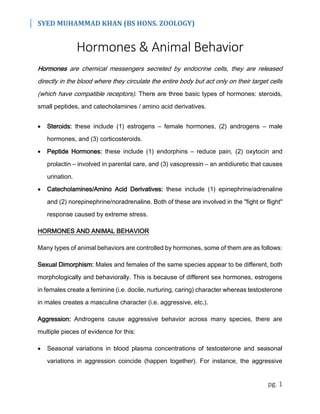
Hormones & Animal Behavior
- 1. SYED MUHAMMAD KHAN (BS HONS. ZOOLOGY) pg. 1 Hormones & Animal Behavior Hormones are chemical messengers secreted by endocrine cells, they are released directly in the blood where they circulate the entire body but act only on their target cells (which have compatible receptors). There are three basic types of hormones: steroids, small peptides, and catecholamines / amino acid derivatives. Steroids: these include (1) estrogens – female hormones, (2) androgens – male hormones, and (3) corticosteroids. Peptide Hormones: these include (1) endorphins – reduce pain, (2) oxytocin and prolactin – involved in parental care, and (3) vasopressin – an antidiuretic that causes urination. Catecholamines/Amino Acid Derivatives: these include (1) epinephrine/adrenaline and (2) norepinephrine/noradrenaline. Both of these are involved in the "fight or flight" response caused by extreme stress. HORMONES AND ANIMAL BEHAVIOR Many types of animal behaviors are controlled by hormones, some of them are as follows: Sexual Dimorphism: Males and females of the same species appear to be different, both morphologically and behaviorally. This is because of different sex hormones, estrogens in females create a feminine (i.e. docile, nurturing, caring) character whereas testosterone in males creates a masculine character (i.e. aggressive, etc.). Aggression: Androgens cause aggressive behavior across many species, there are multiple pieces of evidence for this: Seasonal variations in blood plasma concentrations of testosterone and seasonal variations in aggression coincide (happen together). For instance, the aggressive
- 2. SYED MUHAMMAD KHAN (BS HONS. ZOOLOGY) pg. 2 behavior of male deer is at its peak in autumn, when they are secreting high levels of testosterone. Aggressive behaviors increase at the time of puberty, when the testes become active and blood concentrations of androgens rise. Juvenile (young) deer do not participate in the fighting during the mating season. Males are generally more aggressive than females, i.e. in deer, female deer rarely display aggressive behavior, and their rare aggressive acts are different from the aggressive behavior of aggressive males. Castration (removal of testes) reduces aggression in males, and testosterone replacement therapy restores aggression to pre-castration levels. Territorial Behavior: Due to the aggressive nature of males (due to androgens), a lot of males are territorial, i.e. Lions, and they actively defend their territory from intruders. Parental Behavior: Parental behavior can be considered to be any behavior that contributes directly to the survival of fertilized eggs or offspring that have left the body of the female. Maternal care (from mother) is much more common than paternal care (from father). For example, rats give birth to altricial young (not completely developed, i.e. it has no hair, etc.), and mothers perform various maternal behaviors, including nest building, crouching over the pups to allow nursing and to provide warmth, pup retrieval, and increased aggression directed at intruders. The onset of maternal behavior in rats is mediated by hormones. A fast decline of blood concentrations of progesterone in late pregnancy, in combination with high concentrations of estradiol, prolactin, and oxytocin, induces female rats to behave maternally almost immediately in the presence of pups (babies). EXAMPLES OF HORMONALLY INFLUENCED ANIMAL BEHAVIOR: Some examples of animal behaviors influenced by hormones are as follows:
- 3. SYED MUHAMMAD KHAN (BS HONS. ZOOLOGY) pg. 3 Singing in Zebra Finches: Only male zebra finches sing. If the testes of adult male finches are removed, then the birds reduce singing, but castrated (with removed testes) finches resume singing if the testes are re-implanted, or if the birds are treated with testosterone. Mating behavior of Cats: During mating season, female cats have elevated levels of estrogens in their bodies, i.e. they are in the estrus phase. During this phase, they are said to be in heat and attract the attention of males who also have elevated levels of testosterone in their bodies. The males might even fight with other males to gain access to a female (sexually). Parental Behavior in Hens: Normally hens are very passive (non-aggressive) and tend to avoid predators but when a hen has a clutch (chicks) to take care of, the elevated levels of prolactin in their bodies make them excellent parents. In this case, if a predator (cat) approaches and attempts to prey on the chicks, the hen may confront the predator and ward it off. Monogamy in Voles: Prairie voles (relative of mouse, i.e. a rodent) are extremely monogamous, while their close relatives, Montane voles are polygamous as are most voles. Male prairie voles form a strong pair bond with females, remaining together for life, and showing aggression toward strangers of either sex. Males contribute to parental care and older siblings stay with their parents to help care for new siblings. Hormones are primarily responsible for prairie vole monogamy: In prairie voles, oxytocin causes the female to pair-bond with the male. The vaginal stimulation of birth results in the release of oxytocin, as does mating. Prolactin stimulates parental care in both the male and female. Vasopressin, responsible for fluid balance, also causes aggression and is needed for males to pair-bond with females.
